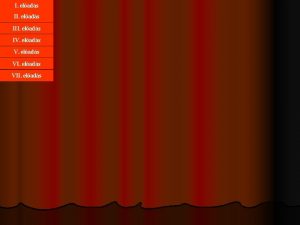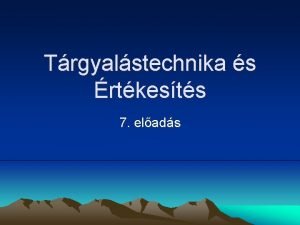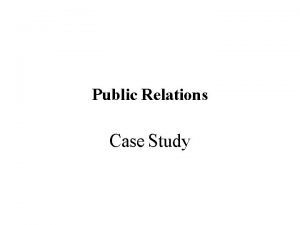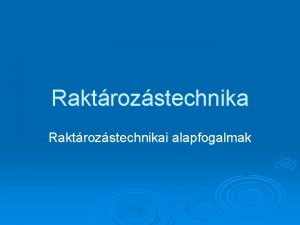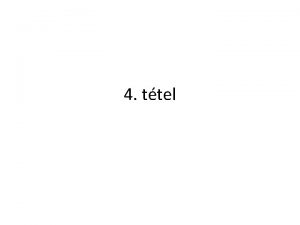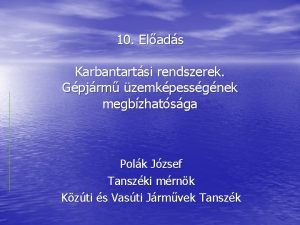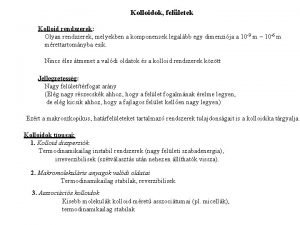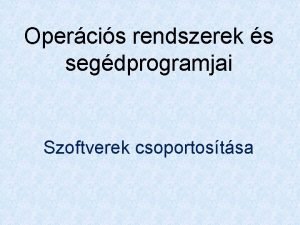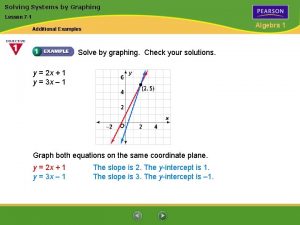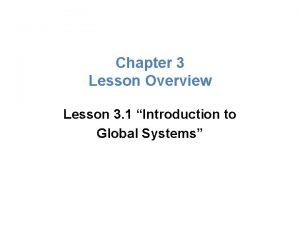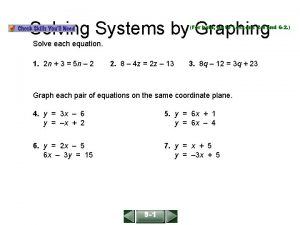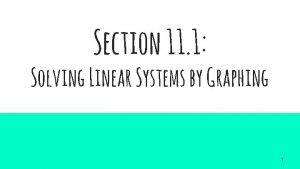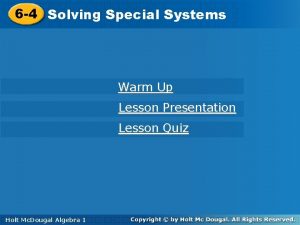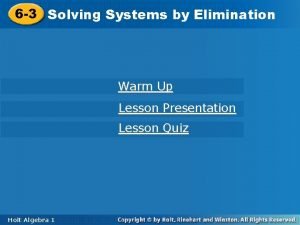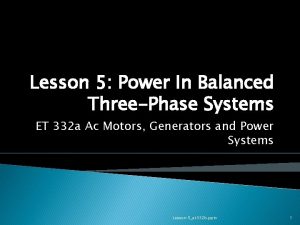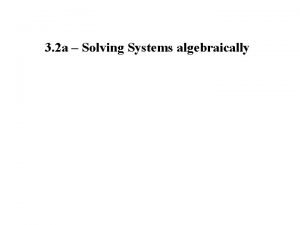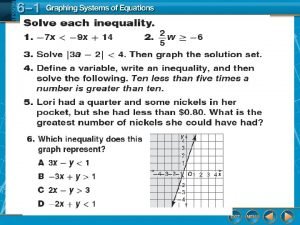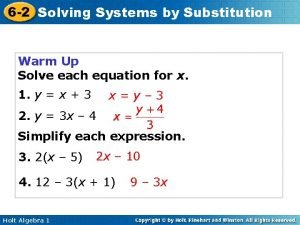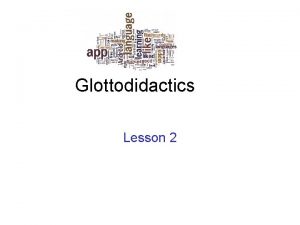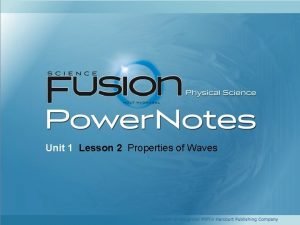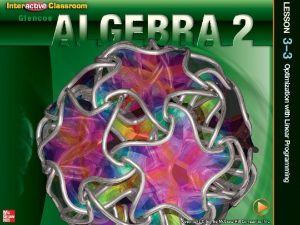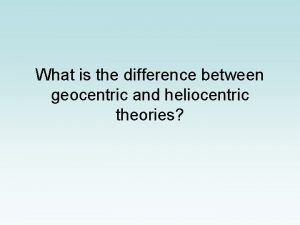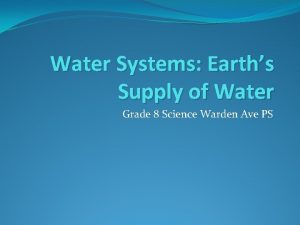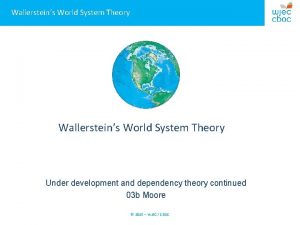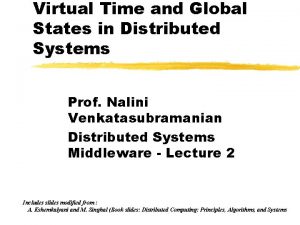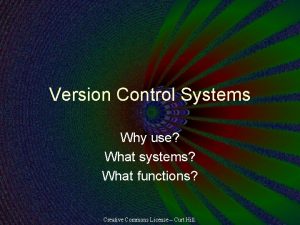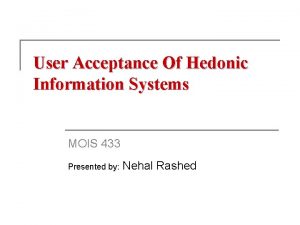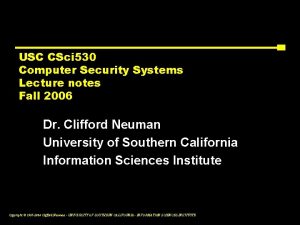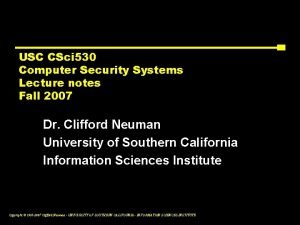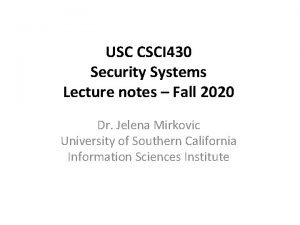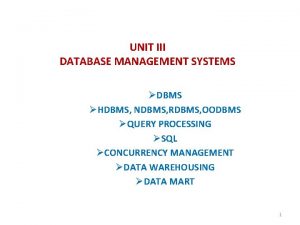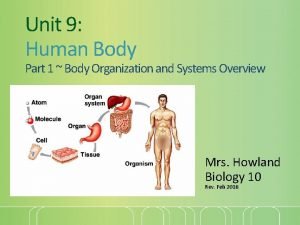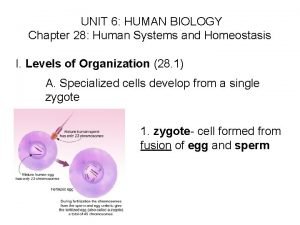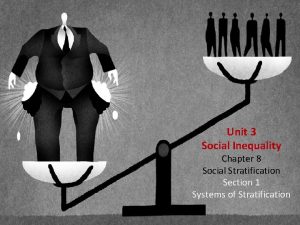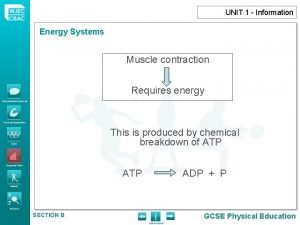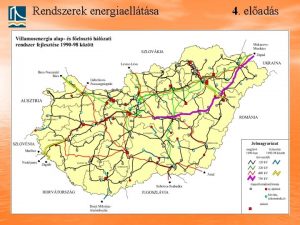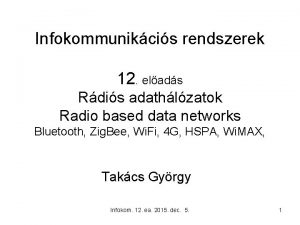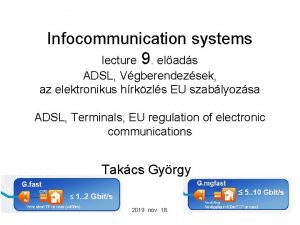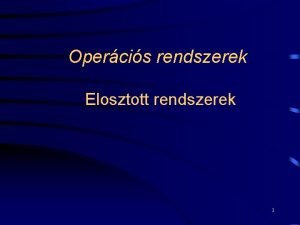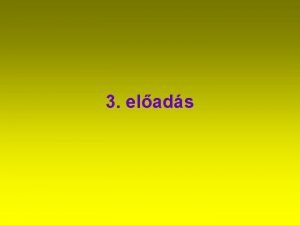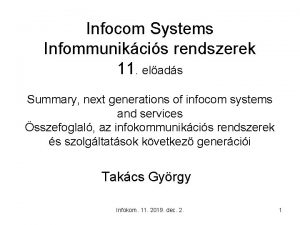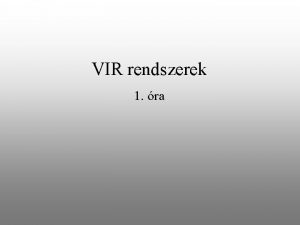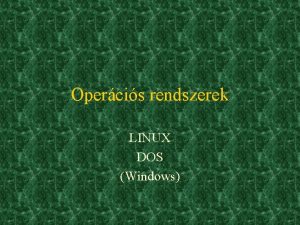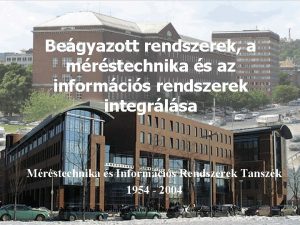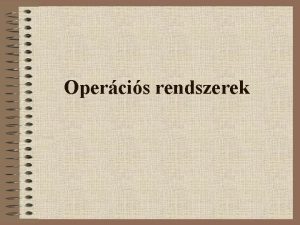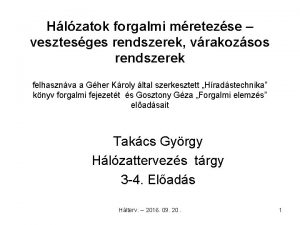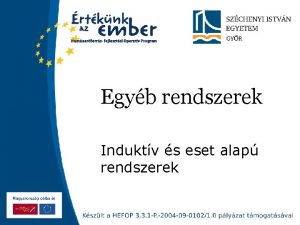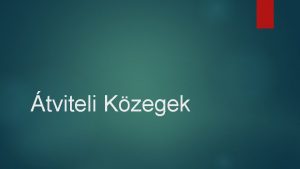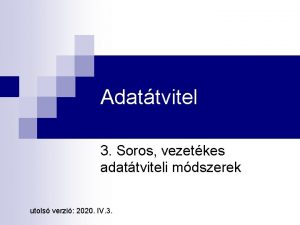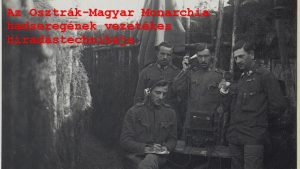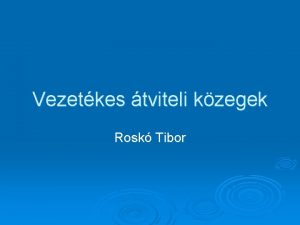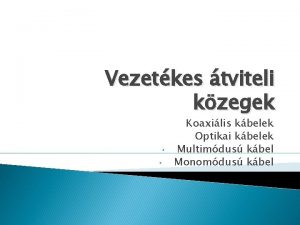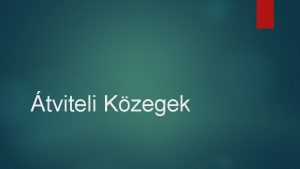Infocommunication systems Infokommunikcis rendszerek Lesson 2 elads Vezetkes


















































































- Slides: 82

Infocommunication systems Infokommunikációs rendszerek Lesson 2. előadás Vezetékes átviteli közegek Wire-line transmission Takács György Infocom 2. ea. szep. 17. 1

Melyik átviteli közeg jobb? Infocom 2. ea. szep. 17. 2

ITK hálózat Fényvezető szálak réz tartalékkal Réz érpárak GSM Rádiós kapcsolat Infocom 2. ea. szep. 17. 3

Vezetékes átviteli közegek • Sodrott érpáras rézkábelek • Koaxiális kábelek • Fényvezető kábelek Infocom 2. ea. szep. 17. 4

A további infrastruktúra tartalék helye infokom. Infocom rendsz. 2. ea. 2. előadás szep. 17. 2010. szept. 13. komea_2_2010 5

Közeg jellemzők • Átviteli tulajdonságok (csillapítás, késleltetés, reflexió, diszperzió, áthallás, zajok, zavaró hatások) • Fektetési, kötési kérdések • Illesztések, szerelvények, végződtetések • Hibák, hibahely-behatárolás Infocom 2. ea. szep. 17. 6

Wireline transmission media • • Symmetrical twisted pair copper cable Coaxial cable Optical fibre cable Constuction issues, connecting, error detection, error localosation. Infocom 2. ea. szep. 17. 7

Media and cable characteristics • Transmission parameters (attenuation, delay, reflection, crosstalk, noises, interferences) • Laying, connecting technologies • Faults, fault localization • Matching, accessories, termination Infocom 2. ea. szep. 17. 8

Symmetric or asymmetric? • Related to the ground • To protect from interferences • The basic equations and characteristics of wires are very similar Infocom 2. ea. szep. 17. 9

Electromagnetic field around the symmetric wire Infocom 2. ea. szep. 17. 10

Infocom 2. ea. szep. 17. 11

Infocom 2. ea. szep. 17. 12

Jelölések • u(x, t) feszültség, a távolság és idő függvénye voltage as the function of time and distance • i(x, t) áram, a távolság és idő függvénye current as the function of time and distance • γ (gamma) komplex csillapítási együttható Attenuation coefficient • R, G, C, L egységnyi hosszú kábelszakasz ellenállása, átvezetése, kapacitása, induktivitása • Zo resistance, conductivity, capacity, inductivity of the unit length cable a kábel komplex bemenő impedanciája The complex input impedance of the cable. A kábel hullámimpedanciája The characteristic impedanceof the cable infokom. Infocom rendsz. 2. ea. 2. előadás szep. 17. 2010. szept. 13. komea_2_2010 13

Equivalent circuit for a (dx) fragment of a wire Infocom 2. ea. szep. 17. 14

The basic equations for wires Infocom 2. ea. szep. 17. 15

The solution of basic equations Infocom 2. ea. szep. 17. 16

Consequence No. 1 waveform of voltage as a function of distance along the wire Infocom 2. ea. szep. 17. 17

Infocom 2. ea. szep. 17. 18

Consequence No. 2 waveform of voltage as a function of time Infocom 2. ea. szep. 17. 19

Transmission properties of wires: attenuation, phase shift, characteristic impedance Infocom 2. ea. szep. 17. 20

Phenomenon at the end of terminated wire Reflection coefficient Infocom 2. ea. szep. 17. 21

Phenomenon at the end of terminated wire example No 1. : matched termination Z=Z 0 NO reflection infokom. Infocom rendsz. 2. ea. 2. előadás szep. 17. 2010. szept. 13. komea_2_2010 ! 22

Phenomenon at the end of terminated wire example No 2. : shortcut at the end Z=0 FULL (negative) reflection ! Infocom 2. ea. szep. 17. 23

Phenomenon at the end of terminated wire example No 3. : open end Z=∞ FULL reflection Infocom 2. ea. szep. 17. ! 24

Phenomenon at the end of terminated wire example No 4. : ohmic termination Infocom 2. ea. szep. 17. 25

Infocom 2. ea. szep. 17. 26

Far end crosstalk and near end crosstalk Infocom 2. ea. szep. 17. 27

Infocom 2. ea. szep. 17. 28

Characteristics of an UTP cabeling passing the CAT 6 specifications Infocom 2. ea. szep. 17. 29

Propagation delay parameters The propagation speed is about 70% of light speed Infocom 2. ea. szep. 17. 30

The reflected signal response at the cable input after sending a nerrow pulse. The far end is terminated by open end! Infocom 2. ea. szep. 17. 31

Attenuation – as a function of frequency Infocom 2. ea. szep. 17. 32

Near end crosstalk as a function of frequency Infocom 2. ea. szep. 17. 33

Characteristics of an UTP cabeling failing the CAT 6 specifications What is the problem with this cable? Infocom 2. ea. szep. 17. 34

Propagation delay parameters The propagation speed is about 70% of light speed Infocom 2. ea. szep. 17. 35

The reflected signal response at the cable input after sending a nerrow pulse. The far end is terminated by open end! There are reflections from a mid position but only in pairs 36 -78! Infocom 2. ea. szep. 17. 36

The attenuation is OK! Infocom 2. ea. szep. 17. 37

Near end crosstalk failed at pairs 36 -78! Infocom 2. ea. szep. 17. 38

The problem is in the cable a wire split at 22, 9 m ! Infocom 2. ea. szep. 17. 39

Infocom 2. ea. szep. 17. 40

Infocom 2. ea. szep. 17. 41

Infocom 2. ea. szep. 17. 42

UTP = Unshielded Twisted Pair Cat-6 twisted pair cabling CAT-6 250 MHz UTP cable supports 1 Gbps Ethernet 1100 -m LAN applications. CAT-6 250 MHz UTP cable only supports 10 Gbps short length applications from 3555 m depending on crosstalk environment. Infocom 2. ea. szep. 18. 43

Cat-7 twisted pair cabling CAT-7 600 MHz individually shielded pair cabling with overall cable shield was initiated by European market leaders and standards bodies for 10 Gbps 100 -m Ethernet LAN applications Infocom 2. ea. szep. 17. 44

Cat-8 twisted pair cabling IEEE-802. 3 bq committee, primarily targeting 40 GBase. T applications. CAT-8 cabling types are already in production CAT-8 cabling is larger in diameter size Infocom 2. ea. szep. 17. 45

CAT-8 Cable 40 Gbps Infocom 2. ea. szep. 17. 46

Infocom 2. ea. szep. 17. 47

Structure of a coaxial cable Infocom 2. ea. szep. 17. 48

Infocom 2. ea. szep. 17. 49

Infocom 2. ea. szep. 17. 50

Infocom 2. ea. szep. 17. 51

Twinax, is a type of cable similar to coaxial cable, but with two inner conductors instead of one. Due to cost efficiency it is becoming common in modern very-short-range highspeed differential signaling applications. Infocom 2. ea. szep. 17. 52

• 100 Gbit Ethernet • 40 GBASE-CR 4 and 100 GBASE-CR 10 physical layers using 7 m twin-axial cable are being developed as part of the 100 Gbit Ethernet specifications by the IEEE 802. 3 bj workgroup; 100 G QSFP 28 DAC is the main type for this application. Infocom 2. ea. szep. 17. 53

Cisco SFP+ Copper Twinax direct-attach cables are suitable for very short distances and offer a cost-effective way to connect within racks and across adjacent racks. Cisco offers passive Twinax cables in lengths of 1, 1. 5, 2, 2. 5, 3 and 5 meters, and active Twinax cables in lengths of 7 and 10 meters. Infocom 2. ea. szep. 17. 54

Infocom 2. ea. szep. 17. 55

Principle of optical fibre Fibre diameter 125μm !!!! Infocom 2. ea. szep. 17. 56

Typical core and cladding diameters -Sizes are in microns Infocom 2. ea. szep. 17. 57

Transport of light in an optical fibre n refractive index Infocom 2. ea. szep. 17. 58

Types of mode propagation in fiber optic cable • Infocom 2. ea. szep. 17. 59

8 8 8 Infocom 2. ea. szep. 17. 60

Attenuation d. B/km Wavelength hullámhossz Infocom 2. ea. szep. 17. 61

Infocom 2. ea. szep. 17. 62

Chromatic dispersion Infocom 2. ea. szep. 17. 63

Principle of Wavelenght division multiplexing (example with three wavelength) Infocom 2. ea. szep. 17. 64

Wavelenght division multiplexing by passive optical devices Infocom 2. ea. szep. 17. 65

Schematic setup of a simple erbium-doped fiber amplifier. Two laser diodes (LDs) provide the pump power for the erbium-doped fiber Infocom 2. ea. szep. 17. 66

Infocom 2. ea. szep. 17. 67

Infocom 2. ea. szep. 17. 68

Infocom 2. ea. szep. 17. 69

Infocom 2. ea. szep. 17. 70

Infocom 2. ea. szep. 17. 71

Infocom 2. ea. szep. 17. 72

optical ground wire (OPGW) used in the construction of electric power transmission combines the functions of grounding and communications. OPGW Infocom 2. ea. szep. 17. 73

Passive optical splitter Infocom 2. ea. szep. 17. 74

Passive optical splitter Infocom 2. ea. szep. 17. 75

Infocom 2. ea. szep. 17. 76

Simple production of glass fibre Infocom 2. ea. szep. 17. 77

Infocom 2. ea. szep. 17. 78

What is cheaper? • Cooling the servers in Europe ir in US? • Travel bits even to the Arctic or Antarctic and operate servers (like Google, Facebook, Twitter, Amazon, Apple, Microsoft) in naturally cold areas? Infocom 2. ea. szep. 17. 79

Behind every Google search, Facebook update, or Twitter tweet lies a gigantic computing infrastructure, at the heart of which sit massive server farms that collectively account for some 230 million tons of carbon dioxide emissions annually -- more than emitted by the entire country of Argentina. Air-conditioning can consume as much as half the total power that digital giants like Google, Facebook, Twitter, Amazon, Apple, Microsoft, and IBM need to run their huge server facilities, and these are growing rapidly. One solution is to move to a place that’s already cold. Naturally cold air and, better yet, cold water, can result in significant energy savings. Locations for server farms are being explored across the far north, from Alaska to Iceland. Google is operating a site in the Finnish town of Hamina. Facebook is building a server farm in Luleå, Sweden, just south of the Arctic Circle. Lefdal, which offers an abundance of clean, renewable energy from nearby hydroelectric dams and wind farms, as well as a unique cooling system that will pump icy cold water from about 650 feet below sea level, is expecting its first tenant to be IBM Norway. Infocom 2. ea. szep. 17. 80

Infocom 2. ea. szep. 17. 81

Infocom 2. ea. szep. 17. 82
 Elads
Elads Elads crm
Elads crm Public candy companies
Public candy companies Raktárak csoportosítása
Raktárak csoportosítása Raktárirányítási rendszerek
Raktárirányítási rendszerek Karbantartási rendszerek
Karbantartási rendszerek Polidiszperzitás
Polidiszperzitás Diszperz rendszerek csoportosítása
Diszperz rendszerek csoportosítása Kontingens szerződés
Kontingens szerződés Fájlmegosztás
Fájlmegosztás Operációs rendszerek csoportosítása
Operációs rendszerek csoportosítása Decision support systems and intelligent systems
Decision support systems and intelligent systems Dicapine
Dicapine Embedded systems vs cyber physical systems
Embedded systems vs cyber physical systems Engineering elegant systems: theory of systems engineering
Engineering elegant systems: theory of systems engineering 4-5 lesson quiz systems of linear inequalities
4-5 lesson quiz systems of linear inequalities Lesson 7 solve systems of equations by graphing
Lesson 7 solve systems of equations by graphing Levels of ecological organization
Levels of ecological organization Lesson 3 the role of government in economic systems
Lesson 3 the role of government in economic systems Lesson 9-1 slope
Lesson 9-1 slope Lesson 3 linear equations in x
Lesson 3 linear equations in x Practice 7-3 solving systems using elimination answer key
Practice 7-3 solving systems using elimination answer key 11-1 solving linear systems by graphing
11-1 solving linear systems by graphing Ac theory 3 lesson 4
Ac theory 3 lesson 4 Lesson 6-4 solving special systems answer key
Lesson 6-4 solving special systems answer key Lesson 6-3 solving systems by elimination answer key
Lesson 6-3 solving systems by elimination answer key Power formula three phase
Power formula three phase 3-1 solving systems of equations
3-1 solving systems of equations Lesson 2-2 graphing systems of inequalities
Lesson 2-2 graphing systems of inequalities Environmental systems unit 3 lesson 2
Environmental systems unit 3 lesson 2 Graphing linear inequalities quiz
Graphing linear inequalities quiz 3-2 solving systems of equations algebraically
3-2 solving systems of equations algebraically Economic systems lesson 2 our economic choices
Economic systems lesson 2 our economic choices 6-1 graphing systems of equations answers
6-1 graphing systems of equations answers 6-2 solving systems using substitution
6-2 solving systems using substitution Lesson outline lesson 3 describing circuits answers
Lesson outline lesson 3 describing circuits answers Mountain building
Mountain building Lesson outline lesson 2 aquatic ecosystems answer key
Lesson outline lesson 2 aquatic ecosystems answer key Micro teaching plan
Micro teaching plan L 101: introduction to health care leadership
L 101: introduction to health care leadership Mind map of gift of chappals
Mind map of gift of chappals What is an overall state of well-being or total health
What is an overall state of well-being or total health Weather forecasts lesson 3 outline answers
Weather forecasts lesson 3 outline answers Sat vocabulary lesson 4
Sat vocabulary lesson 4 Lesson 2 physical properties answer key
Lesson 2 physical properties answer key The science duo physical and chemical changes
The science duo physical and chemical changes Lesson outline climates of earth
Lesson outline climates of earth Lesson outline lesson 1
Lesson outline lesson 1 Lesson 2 measurement and scientific tools
Lesson 2 measurement and scientific tools Fingerprint galton details
Fingerprint galton details Unit 1 lesson 1
Unit 1 lesson 1 Lesson 4 gravity and motion lesson review
Lesson 4 gravity and motion lesson review Lesson 2 muscle storyboard
Lesson 2 muscle storyboard Wave properties lesson 2
Wave properties lesson 2 Today's lesson or today lesson
Today's lesson or today lesson 1 important lesson that is worth sharing about this lesson
1 important lesson that is worth sharing about this lesson Today's lesson or today lesson
Today's lesson or today lesson Lesson outline magnets and magnetic fields answer key
Lesson outline magnets and magnetic fields answer key The sun-earth-moon system worksheet answers lesson 1
The sun-earth-moon system worksheet answers lesson 1 Bounded or unbounded graph
Bounded or unbounded graph Southeast asian alphabets
Southeast asian alphabets Wood frame components
Wood frame components Who traditional medicine strategy 2014-2023
Who traditional medicine strategy 2014-2023 Geo vs heliocentric
Geo vs heliocentric Example of an operating system
Example of an operating system Vi go ladder climbing safety systems
Vi go ladder climbing safety systems Water systems grade 8
Water systems grade 8 Wallerstein model
Wallerstein model Wallerstein's model
Wallerstein's model Virtual time and global states of distributed systems
Virtual time and global states of distributed systems Curriculum guide for driver education in virginia module 10
Curriculum guide for driver education in virginia module 10 Version control systems industry
Version control systems industry User acceptance of hedonic information systems
User acceptance of hedonic information systems Csci 530
Csci 530 Netcheque
Netcheque Csci 430 usc
Csci 430 usc Evolution of operating systems
Evolution of operating systems Transaction processing systems
Transaction processing systems Unit 9 human body systems review
Unit 9 human body systems review Chapter 28 human systems and homeostasis
Chapter 28 human systems and homeostasis Open and closed stratification systems
Open and closed stratification systems Unit 8 ecommerce p2
Unit 8 ecommerce p2 Energy systems graph
Energy systems graph
